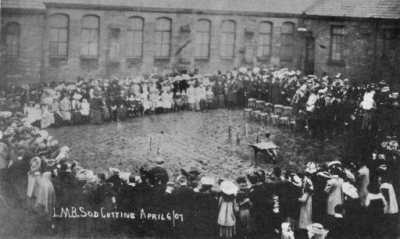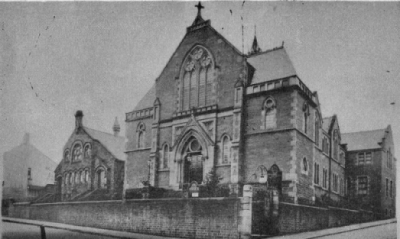5 The twentieth century dawns

As the new century approached, in which a new king, Edward VII, was soon to accede to the throne, a new minister began a Pastorate which was to see fruit; in 1899 the Rev. Burwyn Davies from Swansea was ‘recognised’ in special services at which eight ministers spoke. He was to stir the consciences of many spiritually to turn them to Christ and, socially, to inspire letters to Westminster; 75 people entered the Church by baptism, at least three resolutions were sent to the M.P. For example:– concerning the Education Bill, the following resolutions were forwarded: ‘1. Public money should not support church or Sectarian schools. (The needs of the Children, not the churches should be catered for.) 2. State-supported schools should be controlled by public bodies, not private individuals.’ Others too were politically minded — the Suffragette movement was beginning, the Liberal Party flourishing.
The Building Fund finally got off the ground with an Inaugural Tea in September 1902. This followed an application in 1900 to the Yorkshire Association for a loan of £1,500 which request was repeated in the two succeeding years. It is noted the committee dealing with this application was astonished! Eventually, in 1908, an interest free loan of £500 was granted! To mark the new century the Baptist Union instituted a “Twentieth Century Fund.” Every church contributed handsomely to this, including Lee Mount, and in 1903 we received from this Fund a grant of £500 towards the New Building. The Church’s name was becoming familiar — to the Halifax M.P. (J.H. Whitley), to the Yorkshire Association, and to more people in the Lee Mount district, partly through the summer Sunday Evening ‘Open Airs’ — following the regular service, its choir concerts and the ‘At Homes,’ and through its willingness to let rooms — there is an application in 1905 to use its vestry for inquests! This was received after the resignation of Mr Davies in the same year.
Again there was no lengthy ‘pastorless’ period; in 1906 the Rev. Frederick W. Duncombe arrived, supported by special prayer meetings, ‘for church and pastor.’ In the same year, on a powerful wave of enthusiasm a Building Scheme was under way. Plans of a Bradford architect had been amended, and accepted, for the building, designed to seat 702 people, at a total cost of £4,700. It was to be a far more ambitious building than its modest predecessor: ‘Gothic of the Early Decorated Period.’ The plan of campaign to reach this total was as follows:– to circularise the members for promises of fixed sums of money, to form a ‘Ways and Means’ Committee, to ask the Sunday School for help: they had collecting boxes and books of ‘bricks’ to sell, to ask the District for help, to write to well-known Baptists asking for their written commendation of the scheme (see first page of pamphlet illustrated below). The driving force in all this were notably Mr Clement Hoyle, Secretary of the scheme, and Mr Henry Townsend (Treasurer). Some members lent a total of £500 @ 5%.

May 30th 1908 was the great day of the opening. £2,650 had already been raised. Incidentally the December minutes record the need to take action to counteract draughts.

These were the days when churches were centres for social gatherings: teas, socials, concerts, clubs, e.g. football. There was obviously a strong spirit of enthusiasm for Lee Mount Baptist Church. The Secretary did warn though, as the Building Scheme filled the thoughts and plans of many: ‘Do not forget our real aim — that of winning souls.’ There were those who entered the Church at this time; nevertheless in 1910 he again emphasised the need of the Church ‘to wait more on God’ and reflected at the time of Gypsy Smith’s Mission in Halifax, in the same year, that ‘Lee Mount did not catch the spirit.’ The next year the Rev. Duncombe was to leave for a pastorate in Southampton and, to mark his sterling service to His Master and the Church at Lee Mount, as Sunday School teacher, choirmaster, deacon, Secretary, and more, Mr Henry Townsend was made a life member of the Diaconate.
Mr Duncombe, whose sister, Mrs A.W. Culpan, remains in membership with us, is remembered as ‘smart’ in appearance, and a ‘real gentleman,’ a pastor who won the hearts of all who knew him. Our longest serving member, Mrs N. Sunderland, was baptised by him in 1909.